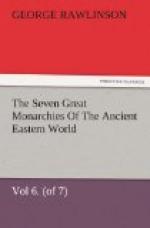CHAPTER X.
Dark period of Parthian History. Doubtful succession of the Monarchs. Accession of Sanatrceces, ab. B.C. 76. Position of Parthia during the Mithridatic Wars. Accession of Phraates III. His relations with Pompey. His death. Civil War between his two sons, Mithridates and Orodes. Death of Mithridates.
The successor of Mithridates II. is unknown. It has been argued, indeed, that the reigns of the known monarchs of this period would not be unduly long if we regarded them as strictly consecutive, and placed no blank between the death of Mithridates II. and the accession of the next Arsaces whose name has come down to us. Sanatrodoeces, it has been said, may have been, and may, therefore, well be regarded as, the successor of Mithridates. But the words of the epitomizer of Trogus, placed at the head of this chapter, forbid the acceptance of this theory. The epitomizer would not have spoken of “many kings” as intervening between Mithridates II. and Orodes, if the number had been only three. The expression implies, at least, four or five monarchs; and thus we have no choice but to suppose that the succession of the kings is here imperfect, and that at least one or two reigns were interposed between those of the second Mithridates and of the monarch known as Sanatroeces, Sinatroces, or Sintricus.
A casual notice of a Parthian monarch in a late writer may supply the gap, either wholly or in part. Lucian speaks of a certain Mnasciras as a Parthian king, who died at the advanced age of ninety-six. As there is no other place in the Parthian history at which the succession is doubtful, and as no such name as Mnascris occurs elsewhere in the list, it seems necessary, unless we reject Lucian’s authority altogether, to insert this monarch here. We cannot say, however, how long he reigned, or ascribe to him any particular actions; nor can we say definitely what king he either succeeded or preceded. It is possible that his reign covered the entire interval between Mithridates II. and Sanatroeces; it is possible, on the other hand, that he had successors and predecessors, whose names have altogether perished.
The expression used by the epitomizer of Trogus, and a few words dropped by Plutarch, render it probable that about this time there were contentions between various members of the Arsacid family which issued in actual civil war. Such contentions are a marked feature of the later history; and, according to Plutarch, they commenced at this period. We may suspect, from the great age of two of the monarchs chosen, that the Arsacid stock was now very limited in number, that it offered no candidates for the throne whose claims were indisputable, and that consequently at each vacancy there was a division of opinion among the “Megistanes,” which led to the claimants making appeal, if the election went against them, to the arbitrament of arms.




